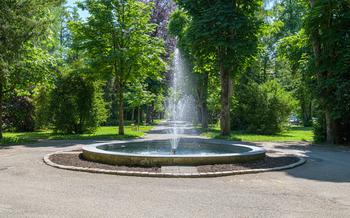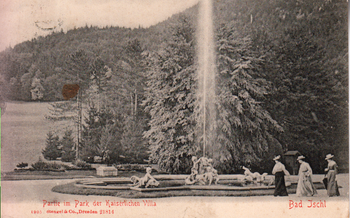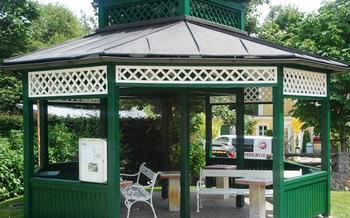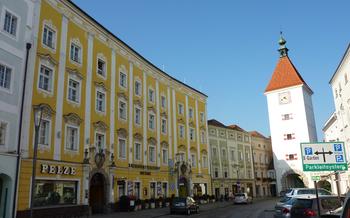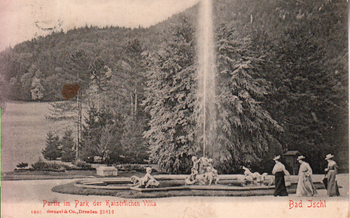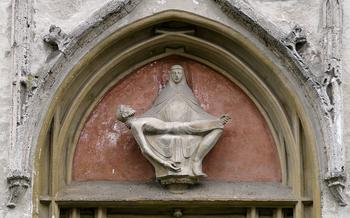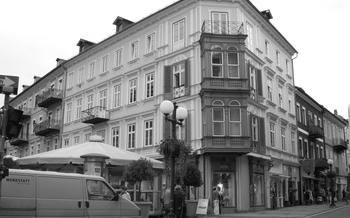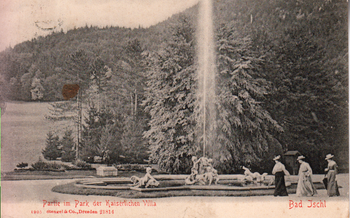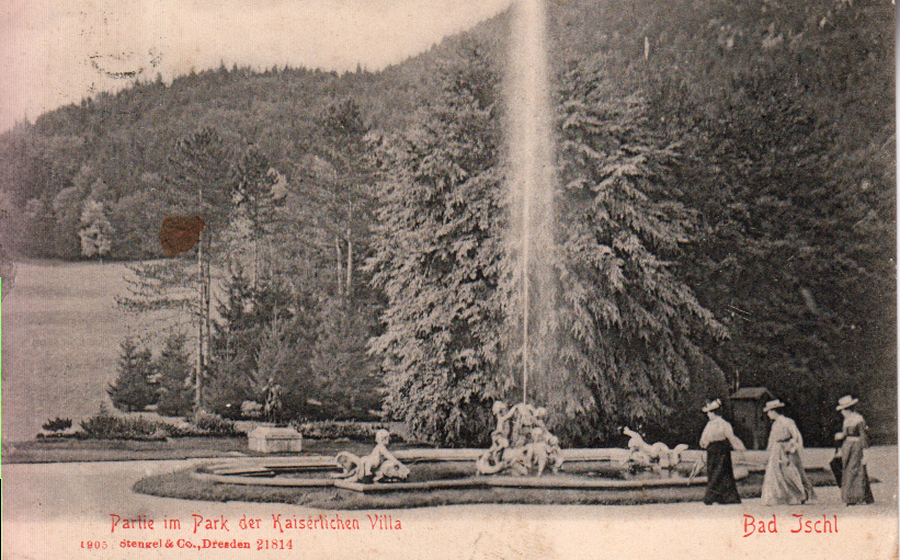
Bad Ischl Imperial Villa and Park
- Architecture and Design
- Imperial Park
- Imperial Apartments
- Emperor's Study
- Imperial Kitchen
- Imperial Hunting Lodge
- Imperial Chapel: A Symbol of Habsburg Piety
- Royal Theater
- Imperial Stables
- Museum of Imperial History
- Insider Tip:
Architecture and Design
The Bad Ischl Imperial Villa stands as a testament to the architectural brilliance of its time. Its unique style blends Renaissance grandeur with Baroque opulence, creating a visually stunning masterpiece. The villa's façade is adorned with intricate carvings, decorative columns, and arched windows, exuding an air of elegance and majesty. The interiors are equally captivating, boasting a harmonious blend of lavishness and functionality. Elaborate chandeliers, ornate mirrors, and gilded accents adorn the walls and ceilings, while the parquet floors add a touch of warmth and sophistication. The villa's rooms are furnished with exquisite pieces of furniture, carefully chosen to reflect the imperial family's taste and lifestyle. From the grand reception halls to the private chambers, every corner of the villa exudes a sense of imperial grandeur and refinement.
Imperial Park
The Bad Ischl Imperial Villa is surrounded by an extensive and picturesque park, covering an area of over 100 hectares. The park was designed in the English landscape style, characterized by its natural, flowing lines and harmonious integration with the surrounding landscape. Visitors can explore a variety of scenic trails, wander through tranquil gardens, and discover hidden gems such as the Marmorschloss, a small castle made of marble.
The park's landscapes are a testament to the imperial family's love of nature and their desire to create a serene and beautiful retreat. The meticulously manicured gardens are a delight for the senses, featuring a vibrant array of flowers, plants, and sculptures. The park also offers a variety of recreational activities, including hiking, cycling, and fishing, providing visitors with the opportunity to immerse themselves in the natural beauty of the surroundings.
Imperial Apartments
Embark on a journey through time as you step inside the imperial apartments of the Bad Ischl Imperial Villa. Guided tours lead you through the opulent chambers, offering a glimpse into the private lives of the imperial family. The meticulously preserved rooms showcase original furniture, artifacts, and personal belongings, providing an intimate look into their daily routines and preferences.
Admire the intricate tapestries, elegant chandeliers, and ornate fireplaces that adorn the grand halls. Each room tells a story of imperial history, showcasing the grandeur and opulence that defined the Habsburg monarchy. The dining room, with its long mahogany table and ornate chairs, transports you back to lavish imperial feasts, while the music room evokes memories of courtly concerts and performances.
In the private apartments of Emperor Franz Joseph I and Empress Elisabeth, discover the personal touches that reflect their individual tastes and interests. The emperor's study, lined with bookshelves filled with his favorite volumes, reveals his passion for knowledge and intellectual pursuits. The empress's salon, with its elegant décor and personal mementos, offers a glimpse into her private world and her love for the arts.
Emperor's Study
Franz Joseph I's personal study within the imperial villa offers a glimpse into the emperor's daily routine and intellectual pursuits. This room served as his private sanctuary, where he conducted state affairs, read extensively, and penned countless letters and documents. The study exudes an aura of scholarly elegance, with floor-to-ceiling bookshelves adorned with a rich collection of books, maps, and historical texts. A large wooden desk dominates the center of the room, where the emperor spent hours poring over documents and making important decisions. Personal touches, such as family photographs and mementos, add a sense of intimacy to the space. Visitors can almost envision the emperor seated at his desk, engrossed in his work, as they explore this fascinating room.
Imperial Kitchen
The imperial kitchen at the Bad Ischl Imperial Villa offers a fascinating glimpse into the culinary traditions of the imperial court. Skilled chefs prepared elaborate meals using fresh ingredients sourced from the surrounding region. The kitchen was equipped with state-of-the-art facilities for its time, ensuring that the imperial family and their guests enjoyed the finest dining experiences.
The intricate details of meal preparation and serving were meticulously followed, reflecting the high standards of the imperial household. Each course was carefully planned and presented, with an emphasis on both taste and visual appeal. From grand banquets to intimate family dinners, the imperial kitchen played a crucial role in the daily life of the Habsburg dynasty.
Imperial feasts were legendary events, showcasing the culinary artistry of the kitchen staff. Lavish menus featured dishes inspired by different cultures and traditions, reflecting the cosmopolitan nature of the Austro-Hungarian monarchy. These feasts were not merely about satisfying hunger; they were expressions of power, prestige, and the grandeur of the imperial court.
The imperial kitchen stands as a testament to the culinary heritage of the Habsburgs and their enduring influence on Austrian cuisine. Visitors to the Bad Ischl Imperial Villa can learn about the history of imperial dining and sample some of the traditional recipes that have been passed down through generations.
Imperial Hunting Lodge
Emperor Franz Joseph I was an avid hunter and spent considerable time pursuing his passion within the vast grounds of the Imperial Park. Deep in the verdant wilderness, nestled amidst towering trees, lies the Imperial Hunting Lodge, a testament to the emperor's love for the sport. This rustic yet elegant retreat was designed to provide a comfortable base for Franz Joseph I during his hunting expeditions.
The lodge's interior exudes a cozy and inviting atmosphere, featuring warm wooden accents, plush furnishings, and a roaring fireplace. Trophies and hunting memorabilia adorn the walls, showcasing the emperor's impressive collection of game. Guests can marvel at the intricate taxidermy, including majestic stags, elusive chamois, and even a rare white stag, a symbol of good fortune and royalty.
Franz Joseph I often invited his closest friends and hunting companions to join him at the lodge. They would engage in lively conversations, share stories of their adventures, and celebrate their successful hunts. The lodge served as a place of camaraderie, where the emperor could escape the pressures of his imperial duties and indulge in his favorite pastime.
Today, visitors to the Imperial Hunting Lodge can step back in time and experience the thrill of the hunt through the eyes of Emperor Franz Joseph I. The lodge stands as a testament to his passion for hunting and offers a unique glimpse into the life of a Habsburg monarch.
Imperial Chapel: A Symbol of Habsburg Piety
Within the confines of the Bad Ischl Imperial Villa, nestled amidst the grandeur of the imperial estate, lies the Imperial Chapel, a sacred sanctuary that exudes an aura of devotion and religious fervor. This private chapel served as a spiritual haven for the Habsburg dynasty, a place of solace and communion with the divine.
The Imperial Chapel is a testament to the deep-rooted Catholic faith of the Habsburgs. Its interior is adorned with intricate religious artwork, including stunning stained glass windows that bathe the space in a kaleidoscope of colors, casting an ethereal glow upon the ornate altar and pews.
The chapel's design reflects the Habsburgs' commitment to opulence and grandeur. Every detail, from the intricately carved woodwork to the gleaming marble floors, speaks to the dynasty's unwavering dedication to aesthetics and reverence.
The Imperial Chapel stands as a symbol of the Habsburgs' deep connection to their faith and their role as protectors of the Catholic Church. It is a place where the imperial family sought spiritual guidance, celebrated religious milestones, and found solace in times of need.
Royal Theater
Nestled within the opulent walls of the Bad Ischl Imperial Villa, the Royal Theater stands as a testament to the Habsburg dynasty's love for the arts. This intimate theater space was a beloved retreat for the imperial family, offering a sanctuary for musical performances, recitals, and theatrical productions.
The theater's modest size belies its grandeur. Its plush red velvet seats, ornate chandeliers, and intricate stage curtains create an atmosphere of regal elegance. The acoustics are impeccable, ensuring that every note and word resonates with clarity throughout the auditorium.
During their summer sojourns in Bad Ischl, the imperial family would grace the theater with their presence, transforming it into a vibrant hub of artistic expression. Renowned musicians, actors, and performers from across the empire were invited to showcase their talents before the discerning imperial audience.
The theater's repertoire was as diverse as the Habsburg dynasty itself. From classical concerts to operatic performances and dramatic plays, the imperial family ensured that their cultural experiences were both eclectic and enriching. These performances not only entertained and inspired the imperial court but also fostered a sense of unity and camaraderie among the Habsburg family and their guests.
Today, the Royal Theater stands as a living testament to the Habsburg dynasty's enduring legacy. It continues to host cultural events, inviting visitors to step back in time and experience the magic of imperial entertainment.
Imperial Stables
Amidst the grandeur of the Bad Ischl Imperial Villa, the Imperial Stables stand as a testament to the Habsburg dynasty's equestrian heritage. These historic stables housed the imperial horses and carriages, playing a crucial role in the daily life and transportation of the imperial court.
The stables exude an aura of historical significance, echoing the grandeur of the imperial cavalry. Visitors can admire the meticulously preserved horse stalls, each adorned with intricate carvings and brass fittings. The stables also showcase a collection of historical carriages, offering a glimpse into the opulent transportation methods of the imperial family.
Beyond their practical function, the Imperial Stables hold cultural and artistic value. The Habsburgs maintained a deep appreciation for horses and horsemanship, considering them symbols of power, nobility, and military prowess. The stables served as a venue for equestrian events, showcasing the skills of the imperial riders and their prized steeds.
Today, the Imperial Stables have been transformed into a museum, offering visitors an immersive experience into the world of imperial equestrianism. Interactive exhibits and historical artifacts provide insights into the breeding, training, and care of the imperial horses. Visitors can also learn about the role of the stables in imperial ceremonies and processions, where the Habsburgs displayed their equestrian splendor.
Exploring the Imperial Stables is a journey through time, allowing visitors to connect with the equestrian traditions and cultural heritage of the Habsburg dynasty. It is a must-visit for history enthusiasts, horse lovers, and anyone seeking a glimpse into the opulent lifestyle of the imperial court.
Museum of Imperial History
The Bad Ischl Imperial Villa is not just a magnificent architectural wonder but also a treasure trove of historical knowledge. The Museum of Imperial History, located within the villa's premises, offers visitors a captivating journey through time, delving into the rich history of the Habsburg dynasty and their reign over the Austro-Hungarian Empire.
Through interactive displays, multimedia presentations, and a diverse collection of artifacts, the museum brings to life the stories of the emperors and empresses who once graced these halls. Visitors can explore exhibits on the imperial family's personal lives, their political achievements, and the cultural and social impact of their rule.
The museum also sheds light on the significant events that shaped the course of Austrian history, from the rise and fall of the Habsburg Empire to the challenges and triumphs of the 20th century. It provides a comprehensive understanding of the imperial era and its enduring legacy on modern-day Austria.
Whether you're a history buff, a culture enthusiast, or simply curious about the lives of the imperial family, the Museum of Imperial History offers a fascinating and informative experience that will transport you back in time to a world of elegance, power, and intrigue.
Insider Tip:
For an unforgettable experience, plan your visit to the Bad Ischl Imperial Villa and Park during the off-season (autumn or spring) to avoid the crowds and relish the tranquility of the surroundings. Explore the hidden gem of the Marmorschloss, a charming marble castle nestled within the park, offering breathtaking views of the surrounding landscape. Indulge in local culinary specialties at one of the traditional restaurants in Bad Ischl, savoring the flavors of Austrian cuisine.
